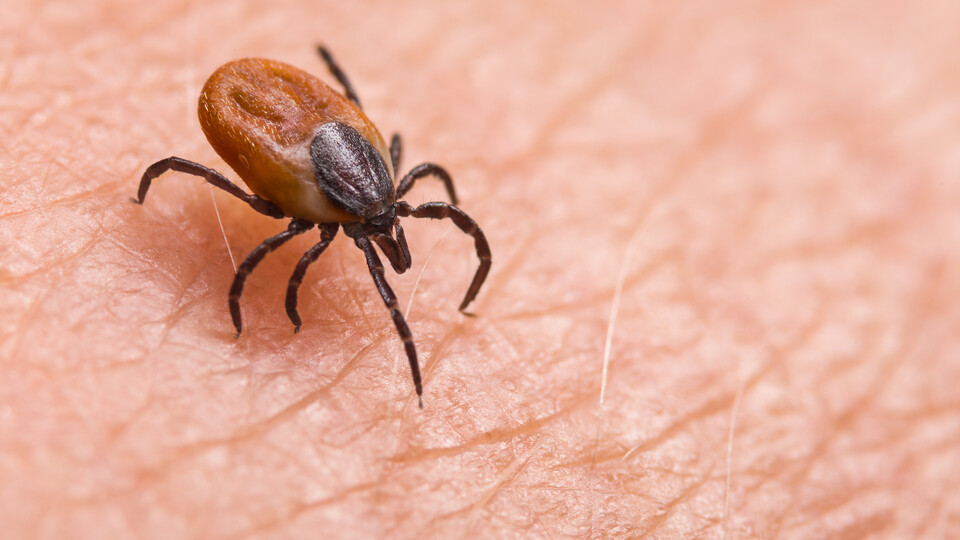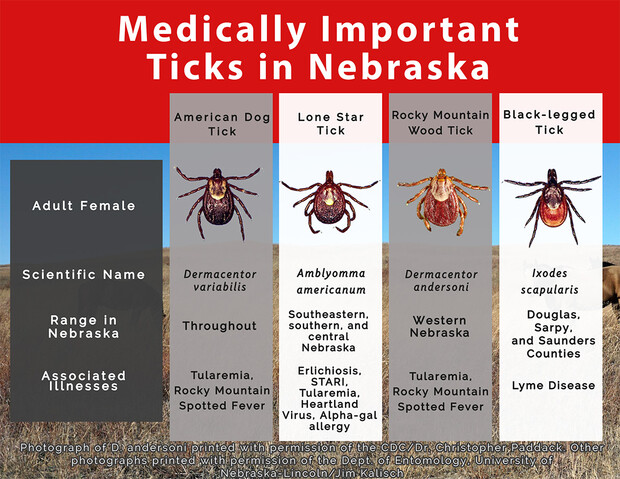To determine current ranges and predict future ones, Dominic Cristiano collaborated with with Roberto Cortiñas, assistant professor in veterinary sciences, to examine data compiled from 1911 to 2011.

A tick crawls on the skin of a human.
After eons of landing on the legs and arms of humans and animals, ticks have landed smack-dab in the middle of the research interests of University of Nebraska–Lincoln master’s student Dominic Cristiano.
Cristiano, a member of the NSF National Research Traineeship Program at Nebraska, studies issues at the intersection of human health, wildlife disease and the environment, and these eight-legged critters (yes, ticks are arachnids, not insects) suck the blood of their hosts and spread diseases such as Rocky Mountain spotted fever, Lyme disease, Alpha-gal and Heartland virus.
Cristiano and his co-advisors, Elizabeth Van Wormer and Larkin Powell, are working to lower the health risks ticks pose in Nebraska by creating maps showing the territories of the four species considered the greatest threats in the state. The species are the Rocky Mountain wood tick, Lone Star tick, blacklegged tick and American dog tick.
“We are creating maps showing the current distribution of these medically important tick species and then also maps of suitable habitat that might be at risk for future invasion from the tick species,” Cristiano said. “As a follow-up to that, we plan to do human dimensions work where we survey lay users’ risk perception for tick-borne diseases and different tick issues throughout the state and compare the perceived risk of tick-borne diseases and how that lines up with the actual assessed ecological risk.”
To determine current ranges and predict future ones, Cristiano collaborated with with Roberto Cortiñas, assistant professor in veterinary sciences, to examine data compiled from 1911 to 2011. The data includes hospital records, museum records and other tick collection records from around the state and nation. Cristiano is also working to build a partnership with the Nebraska Department of Agriculture and the “Tick Tag Go” citizen science effort through iNaturalist. He will use the data amassed and knowledge of habitats suitable for ticks to produce the maps.

Cristiano developed this chart to show the four tick species he is mapping in Nebraska.
Ticks cannot hop or fly, so they typically crawl up grass blades and hang there until they are able to latch onto a passerby. The more daredevil ones may drop from trees onto their prospective host. These tick behaviors give clues to their suitable habitats and ways to lower risks of coming into contact with them.
“Because a lot of tick species need tall, dense vegetation or shrubby areas to stay cool under, property owners can lower the risks of tick infestation by mowing and not letting vegetation get too overgrown,” Cristiano said.
Some property owners spray their land with acaricide (tick and mite poison), and others have suggested the possibility of using chemicals to either sterilize or alter the genomes of ticks to stop them from passing on diseases.
Cristiano cautioned that ticks can develop acaricide resistance and altering their genomes could be a mistake.
“I am always leery of those kinds of interventions just because if we have learned anything throughout the history of ecology, it is that there are always unintended consequences and, often, unintended consequences with pretty long lag times,” he said. “So, we might think this could be a great thing to do to affect the genome of ticks to cure them of the diseases, but we don’t really know what the impact of that will be.”
He stressed that ticks are a part of the food chain and part of the resilience of ecosystems.
“There are so many animals that eat ticks, even chickens,” he said. “Chickens on people’s farms are a natural way of tick control, as well as other animals found in their habitat, so I am, especially through this master’s program and the classes I have been taking, starting to realize the importance of all the little interactions in the food chain and how that strengthens the resilience when you have all of that diversity working together.”
Aside from mowing and setting chickens loose to combat ticks, Cristiano suggested awareness and preparation as the best methods to handle the risks of tick exposure.
“I think your first line of defense is always to be aware of your risks and be prepared for the risk that you face,” he said.
He suggested that once people become aware of their risks, perhaps through the maps he is developing, they might choose to wear long clothing sprayed with DEET to help prevent tick contact when in their territories. Once people arrive home after being in a tick habitat, they should check themselves for ticks.
“When you’re in the shower, check your entire body for ticks, especially for ones that are really small,” he said. “They can be in areas that are really hard to see.”
The recommended method of removing ticks is using tweezers to grasp the head of the tick as close to the skin as possible and then pulling up slowly and steadily. Once the tick is removed, clean the area with rubbing alcohol or a disinfectant. Some doctors recommend saving the tick in a baggy or bottle with alcohol to preserve it for identification later in case you become sick.
Cristiano’s interest in the medical and ecological significance of ticks has furthered his understanding of resilience as he takes part in the NRT, the Council for Resilience Education and One Health, a program focused on human, animal, plant and ecosystem health. He never foresaw that he would research ticks when coming to Nebraska from Cleveland, Ohio.
“If you would have asked me before I came to Nebraska if I were going to be studying ticks at all, I would not have guessed that,” he said. “I had broad interests coming in, but I was coming off an undergraduate project where I was looking at waterfowl diversity.”
As he and Powell explored waterfowl and their diseases, they branched off into research on ticks. Soon, Cristiano discovered the eight-legged critters had somehow managed to crawl over a very low bar of appeal.
“The more that I learn about ticks, the more interested I get in tick ecology and, I know they’re not insects, but in insect ecology in general, just thinking of how well adapted these species are is really crazy to think about for me,” he said. “I don’t think I’m probably going to go on to be a tick biologist in my career, but I definitely do think that wildlife disease ecology and just disease ecology in general is something I’m becoming really passionate about and something that I can see myself doing.”
